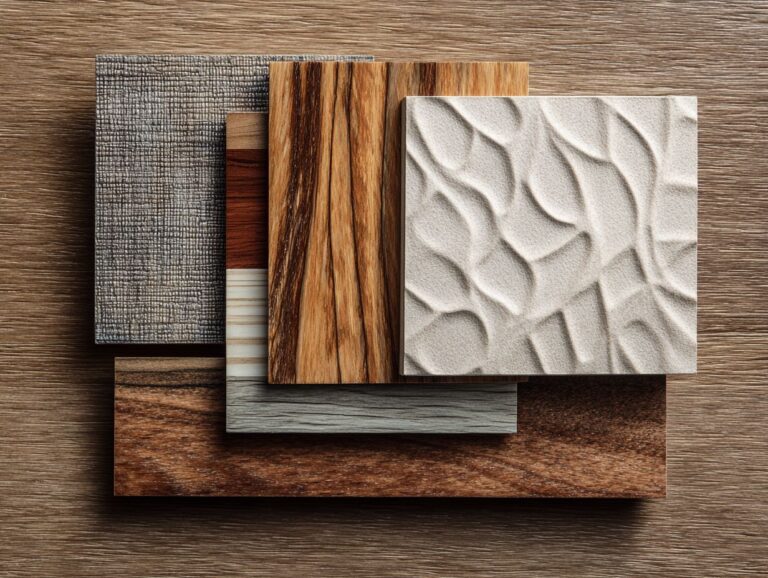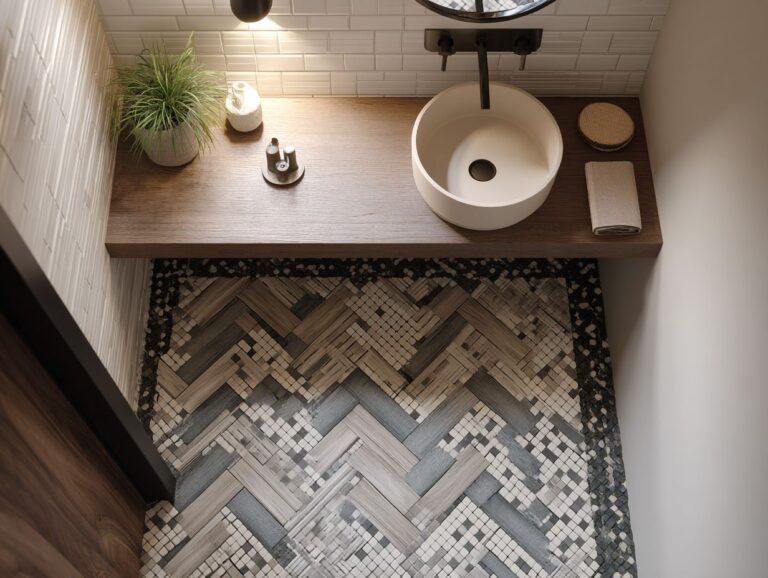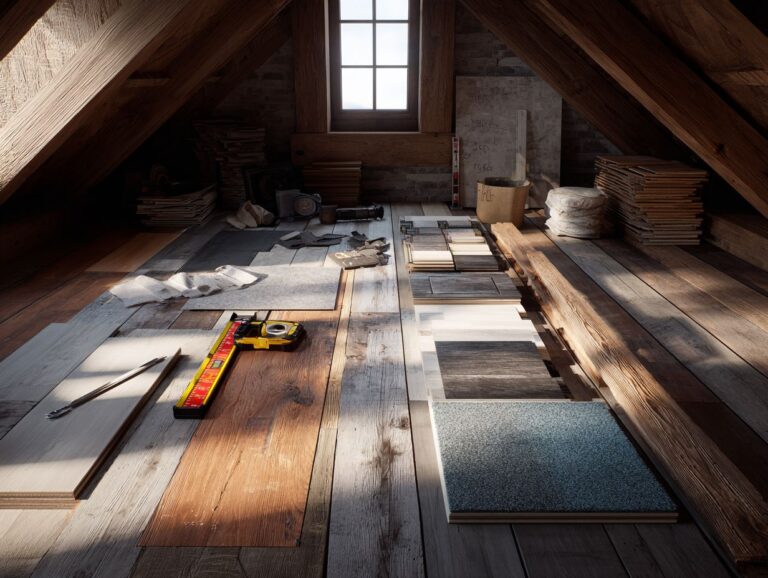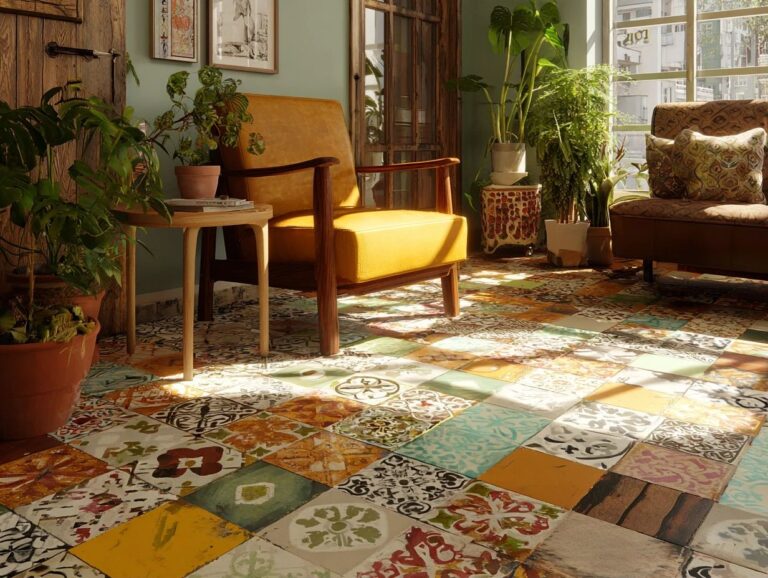Farmhouse Flooring Trends – Rustic Modern Balance
Enjoy the appeal of today’s farmhouse style with new flooring concepts that mix rustic charm with a modern look. Experts Natalie Walton and Robin Rains discuss how using texture and pattern can make your space feel warm and stylish. In this article, we look at the most popular farmhouse flooring styles. This guide will give you ideas for your home renovation and help you mix modern and rustic looks effectively.
Key Takeaways:
Contents
Defining Rustic Modern Style
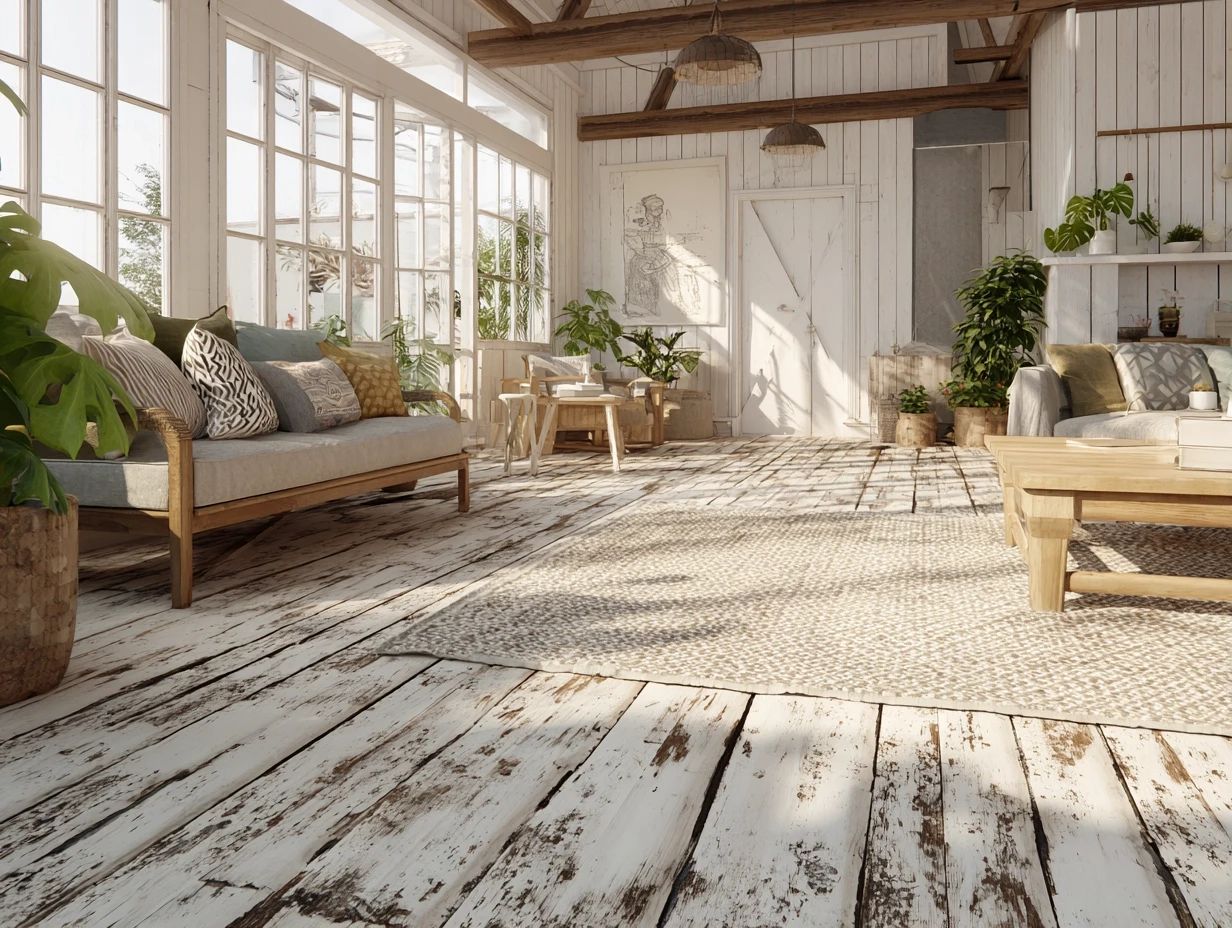
Rustic modern style combines natural materials and old-fashioned pieces with simple lines and minimal decoration, creating a special look that appeals to those who love farmhouse style.
This style appears in the work of designers like Natalie Walton, who frequently uses old wood, metal accents, and vintage fabrics to make spaces feel inviting and stylish.
To achieve this look at home, consider incorporating elements such as:
- Exposed timber beams
- Neutral color palettes
- Statement pieces like a distressed leather sofa
Pair these with modern fixtures, like sleek pendant lighting, to create a harmonious balance between rustic charm and contemporary elegance.
Importance of Flooring in Home Aesthetics
Flooring serves as the foundation of home aesthetics, influencing the overall vibe and functionality of spaces, particularly in high-traffic areas.
Wide plank flooring creates a spacious and comfortable atmosphere, perfect for contemporary rustic designs. Distressed wood flooring gives a home a vintage look with its unique character and charm, and its strong surface makes it long-lasting.
Both options can be paired effectively with area rugs to create inviting zones. Engineered hardwood resembles solid wood but handles moisture more effectively, making it ideal for kitchens or basements. Worth exploring: Biophilic Design and Natural Flooring Materials can further enhance your space with nature-inspired aesthetics.
Popular Flooring Materials
Picking the right flooring is important for getting the farmhouse look you want.
You can choose from many types to match your style and needs (our guide on wide plank flooring explores one popular option).
Hardwood Flooring
Hardwood flooring remains a top choice in farmhouse design, offering durability and a natural beauty that complements rustic aesthetics.
Different styles like reclaimed wood, oak, and maple improve a home’s look and increase its worth.
For example, reclaimed wood, often sourced from old barns, can add a unique charm and typically costs between $8-$15 per square foot. New oak flooring usually costs $5 to $10 per square foot, which is a budget-friendly option for many homeowners.
Choosing hardwood flooring improves the look of your home and gives you lasting value for your money.
Laminate Options
Laminate flooring is a budget-friendly option that looks like hardwood and is easy to care for.
This makes it an ideal choice for high-traffic areas such as living rooms or entryways.
When selecting laminate, consider options like:
- Empire Today, which offers styles starting at $2 per square foot
- Shaw, known for scratch-resistant surfaces
For added durability, look into waterproof options like AquaGuard.
Setting it up usually means joining planks together, allowing DIY fans to complete it in a weekend.
This combination of aesthetics and practicality helps create a stylish yet resilient flooring solution.
Vinyl Plank Innovations
Vinyl plank flooring is popular because of its new designs and water-resistant qualities, which make it a good choice for contemporary farmhouse kitchens and bathrooms.
Recent trends showcase luxury vinyl tiles (LVT) that beautifully mimic natural materials like hardwood and stone.
For example, products such as Shaw Floorte ($3-$7 per square foot) offer stunning oak visuals with excellent durability, while Mannington Adura Max ($4-$6 per square foot) provides a realistic stone appearance combined with softness underfoot.
Both options are waterproof and scratch-resistant, making them ideal for high-traffic areas.
Consider brands like Mohawk RevWood for eco-friendly solutions that uphold aesthetic appeal without sacrificing performance.
Tile Choices for a Rustic Look
Tile provides many choices for creating a rustic appearance, with materials such as terracotta and checkerboard tiles adding charm to areas.
To improve your farmhouse look, think about using handmade zellige tiles. They are priced between $15 and $30 each and have a distinctive handmade look.
Another option is using reclaimed wood planks for a cozy, natural appearance. Their cost typically depends on age and quality, yet they always offer a classic look.
For a classic touch, classic black and white checkerboard tiles can create striking visual interest, especially in kitchens or entryways.
Putting these materials together carefully can improve the rustic feel of your space.
Color Trends in Farmhouse Flooring
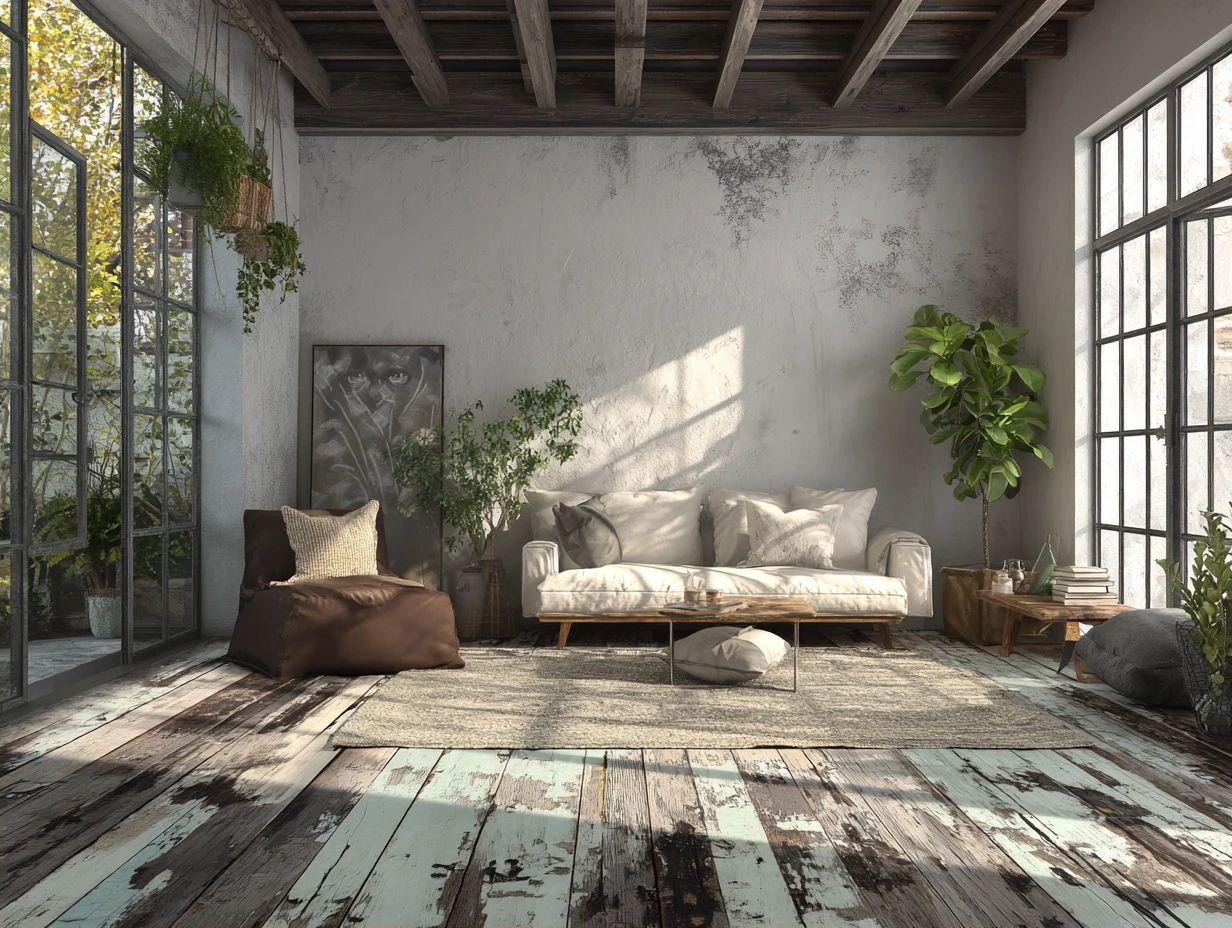
Color trends in farmhouse flooring are important for setting the mood of a space, with options from muted greys to bright accents. These choices often align with broader design movements, as mentioned in our analysis of 2025 Flooring Trends – Colors, Materials, Patterns, where the evolution of color trends plays a pivotal role in modern interior design.
Neutral Palettes
Neutral palettes, including muted greys and warm beige tones, are prevalent in farmhouse flooring, providing a calming backdrop for decorative elements.
These colors improve the look and easily fit with different decoration styles. For example, Quick-Step’s laminate in `Grey Oak’ offers durability and easy maintenance paired with a soft, inviting hue.
Similarly, Shaw Floors’ `Peanut Butter’ carpet in a warm beige creates a cozy atmosphere, perfect for living spaces. By selecting flooring in these neutral colors, homeowners can easily add bright accessories or rustic wooden pieces, allowing flexibility in their design choices.
Bold Accents
Bright-colored paint and terracotta shades can bring out the character of farmhouse flooring, adding personality to interiors.
To effectively use striking color accents, begin by selecting a matching color scheme. For example, pairing a deep navy blue with warm wooden floors brings out the rustic charm typically found in farmhouse designs.
Consider using color psychology: blue promotes calmness, while terracotta evokes warmth and comfort. Use these colors strategically on accent walls or furniture pieces to draw attention without overpowering the space.
A successful example is a kitchen makeover where a bright yellow island was combined with soft grey flooring, creating a lively and balanced feel.
Textural Elements
The texture of flooring adds greatly to the rustic look, providing both visual beauty and a unique feel. For those interested in the connection between natural materials and design aesthetics, our article on Biophilic Design and Natural Flooring Materials offers more insights.
Distressed Finishes
Distressed finishes give a vintage appearance that adds to the rustic charm of farmhouse interiors, usually done with specific techniques.
One popular method to achieve distressed finishes is using hand-scraping techniques, which involves physically altering the wood’s surface to create an aged appearance.
Alternatively, you can use products like pre-distressed hardwood flooring from brands such as Armstrong or Mohawk, which offer options that replicate this look without extensive labor.
Another effective approach is applying a faux finish using stain and glaze; for instance, a dark walnut stain followed by a light cream glaze can mimic the depth of natural aging.
In the end, choose what matches your design goals and how much you want to spend.
Natural Textures
Natural textures, such as stone surfaces and handmade details, are important for creating the farmhouse style.
Adding these textures improves visual appeal and makes the space warm and inviting.
Handmade tiles show unique designs and color differences that highlight skill and care. Pairing these tiles with reclaimed wood flooring can evoke a rustic charm.
Use natural stone, like slate or travertine, in outdoor areas to provide a seamless flow between interiors and exteriors, enhancing the farmhouse feel.
Consider sourcing these materials locally to support artisans and add authenticity to your design.
Eco-Friendly Flooring Options
More and more homeowners are choosing eco-friendly flooring because it uses sustainable materials and still looks good.
Sustainable Materials
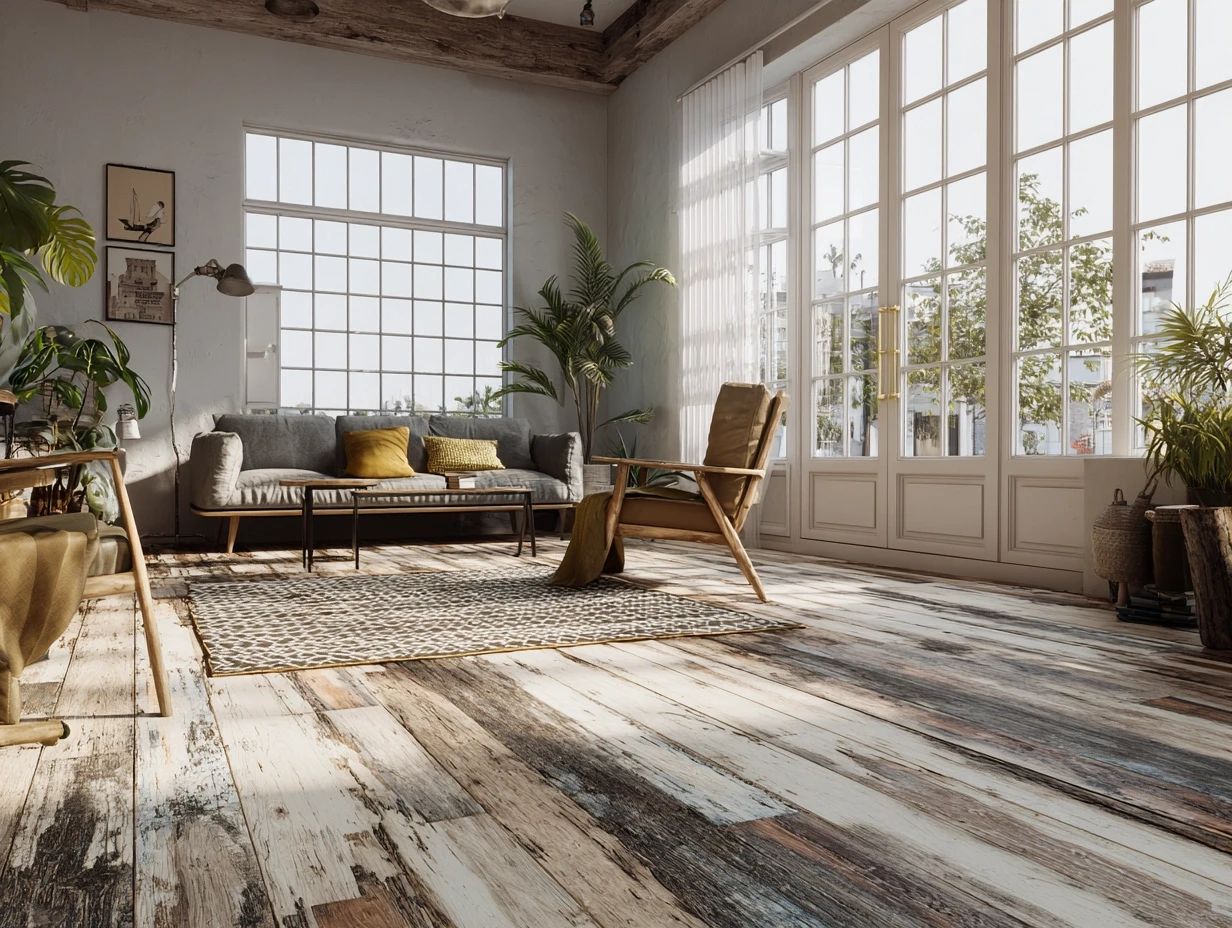
Sustainable materials, such as bamboo and cork, offer eco-friendly alternatives that are both stylish and practical for modern homes.
Bamboo, priced around $3 to $5 per square foot, is rapidly renewable and can thrive in diverse environments.
Cork, priced at $4 to $8 per square foot, is taken from the bark of cork oak trees safely, providing a great choice for insulation and reducing noise.
Both materials lower carbon emissions and are long-lasting.
When choosing, consider factors like maintenance; bamboo requires periodic refinishing, while cork benefits from sealants to prevent moisture damage, ensuring longevity and sustainability.
Reclaimed Wood Usage
Using reclaimed wood adds a rustic look and helps the environment by reusing old materials.
Incorporating reclaimed wood in flooring brings unique character and durability to any space. This wood often comes from sources such as old barns or factories, giving each plank a story.
The pricing typically ranges from $5 to $15 per square foot, depending on the species and quality. When sourcing, look for local suppliers to minimize environmental impact and support your community.
Online platforms like Etsy and Reclaimed Wood Exchange can also provide unique options. These decisions improve how your home looks and help you feel more connected to the materials.
Combining Rustic and Modern Elements
Mixing old-fashioned and new styles in flooring adds interest and improves the overall look of a home.
Mixing Materials
Mixing materials, such as combining hardwood with tile accents, can result in a visually appealing and functional flooring solution.
To achieve a cohesive design, consider these actionable tips:
- Start by selecting a unifying color palette that complements both materials; for instance, if your hardwood is a warm oak, choose tiles with similar tones.
- Next, use transition strips or molding to create a seamless flow between the two materials.
- A popular combination is installing hardwood in the living areas and using large-format ceramic tiles in the kitchen. This clearly separates areas and increases strength where it’s needed most.
- Trying out different layout patterns can make your design better.
Creating Cohesive Spaces
Creating cohesive spaces involves thoughtful planning of flooring transitions and visual patterns that unify the overall design.
-
Start by selecting compatible materials. For instance, pairing hardwood with luxury vinyl planks can create a seamless flow.
-
Use transition strips, such as T-molding, to provide a smooth change from one type to another while avoiding tripping hazards.
-
Employ strategic flooring patterns, like diagonal layouts, to guide the eye across different areas.
-
Make sure colors go well together; warm oak matches nicely with beige tile.
-
Visual examples, like rooms featuring layered rugs or contrasting borders, can further illustrate how to achieve harmony in diverse flooring choices.
Maintenance and Care for Farmhouse Flooring
Looking after farmhouse flooring well is important to maintain its appearance and durability, ensuring it remains a timeless choice.
Cleaning Tips
Regular cleaning tips, such as using gentle cleaners on hardwood and avoiding harsh chemicals, can significantly extend the life of your flooring.
For hardwood floors, use a mixture of warm water and a few drops of dish soap for routine cleaning.
For tile, a pH-neutral cleaner keeps the grout looking fresh without damage. Carpets benefit from regular vacuuming and occasional steam cleaning, which can remove deep-set stains and allergens.
Products like Bona Hardwood Floor Cleaner and Zep Grout Cleaner are excellent choices. Test a hidden spot first to check that it works with your floor and prevent permanent harm.
Longevity Considerations
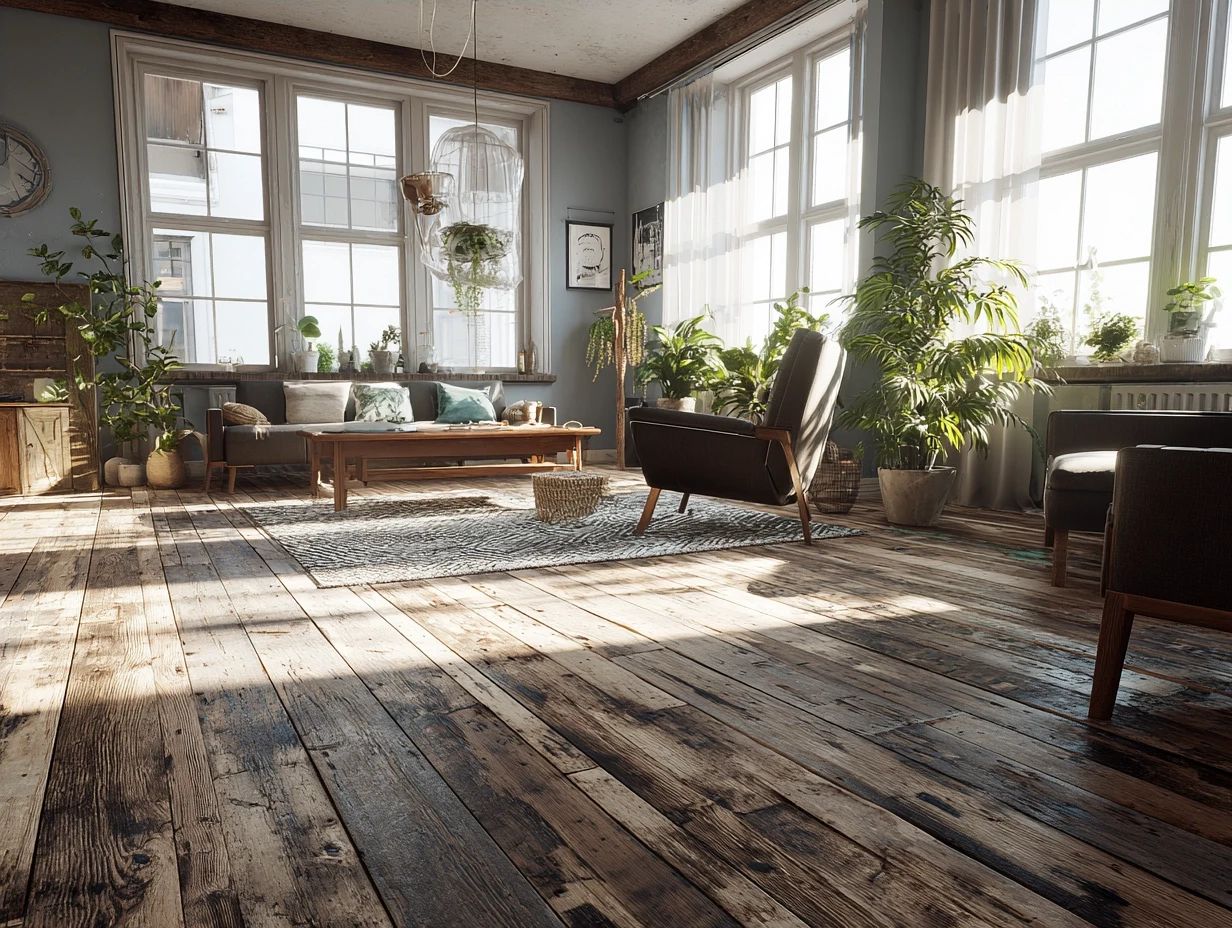
Knowing how long different flooring materials last helps homeowners choose options that stay beautiful for years.
Different flooring options offer varying lifespans influenced by factors like foot traffic and maintenance.
Hardwood floors can last from 20 to 100 years depending on the wood type and finish, making them a popular choice in high-end homes.
Laminate, recognized for its budget-friendliness, generally lasts about 15-25 years, but can wear down faster in areas with heavy foot traffic.
Vinyl flooring shines with its durability, often lasting 10-20 years, but can be prone to scratches.
Regular maintenance, such as cleaning and refinishing, can extend the life of all materials significantly.
Predictions for Farmhouse Flooring
It is expected that farmhouse flooring will increasingly use eco-friendly materials and new designs that improve both look and usefulness.
Homeowners are choosing eco-friendly materials such as bamboo or reclaimed wood more often because they lower environmental impact and give the space a distinct look.
For example, bamboo flooring is strong and doesn’t get damaged easily by water, so it’s a great option for places where people walk a lot.
Modern designs, such as wide planks or wire-brushed finishes, complement traditional farmhouse aesthetics while providing a fresh look. When choosing flooring, consider local suppliers who specialize in sustainable materials to support regional economies and reduce transportation emissions.
Farmhouse Flooring Trends 2024
Farmhouse Flooring Trends 2024
The Farmhouse Flooring Trends 2024 This overview looks into present and new trends in flooring choices designed for the rustic and inviting style of farmhouse interiors. Although the dataset does not provide specific metrics or numerical data, we can infer key points based on industry trends and consumer preferences.
Popularity of Flooring Types: Farmhouse flooring often features certain materials that are well-liked for their country-style look and long-lasting quality:
- Reclaimed Wood: One of the most sought-after choices, reclaimed wood offers a weathered, vintage look that aligns perfectly with the farmhouse style. Its sustainability appeal also adds to its popularity.
- Wide Plank Flooring: Wide planks are favored for their classic and expansive appearance, lending a sense of openness and continuity to farmhouse interiors.
- Engineered Hardwood: Combining aesthetic appeal with practical benefits, engineered hardwood provides the look of solid wood with better resistance to moisture and temperature changes.
- Luxury Vinyl Plank (LVP): LVP is becoming a favored option because it looks like wood or stone but is more durable and easier to maintain, which is great for busy areas.
- Natural Stone: For a more rustic and authentic feel, natural stone options like slate or travertine are favored. They bring texture and a natural element that complements the farmhouse aesthetic.
Design and Color Trends: Flooring design and colors are essential in creating the farmhouse style:
- Neutral Tones: Neutral and earthy tones such as beige, gray, and white are prevalent, creating a warm and inviting atmosphere.
- Distressed Finishes: Distressed or hand-scraped finishes add character and a sense of history, enhancing the rustic charm of farmhouse interiors.
- Patterned Floors: Herringbone and chevron patterns are gaining traction for their ability to add visual interest while maintaining a classic look.
Sustainability and Eco-friendliness: There is a growing emphasis on sustainable and eco-friendly flooring options in the farmhouse trend. Consumers are increasingly looking for materials that are responsibly sourced and have a lower environmental impact. This includes the use of reclaimed wood, bamboo, and cork flooring.
In summary, the Farmhouse Flooring Trends 2024 focus on materials and designs that improve the rustic, cozy, and lasting charm of farmhouse interiors. Key trends include the use of reclaimed wood, wide plank flooring, engineered hardwood, LVP, and natural stone. Neutral colors, worn surfaces, and patterned floors are popular design choices, while making environmentally friendly decisions is an important factor for buyers. These trends collectively contribute to creating inviting and aesthetically pleasing farmhouse spaces.
Frequently Asked Questions
1. What is the best type of flooring to achieve a rustic modern balance in a farmhouse?
The best type of flooring for a rustic modern balance in a farmhouse is reclaimed hardwood. This type of flooring is durable and has a natural and weathered look that adds to the rustic charm of a farmhouse. It also complements modern elements with its clean lines and smooth finish.
2. Can I use tile or stone flooring to achieve a rustic modern balance in a farmhouse?
Yes, you can use tile or stone flooring to achieve a rustic modern balance in a farmhouse. Look for options with a distressed or textured finish to add a rustic touch. Pair it with modern furniture and dcor to create a balanced and unique look.
3. Are there any flooring materials that are both rustic and modern?
Yes, there are flooring materials that combine both rustic and modern elements. For example, hand-scraped hardwood flooring has a distressed look that adds a rustic feel, but is also available in modern finishes and colors. Concrete flooring can look both rustic and modern at the same time.
4. How can I add color to my farmhouse flooring to achieve a rustic modern style?
To add color to your flooring while maintaining a rustic modern balance, consider using patterned or textured area rugs. You can also look for distressed hardwood flooring in a unique color such as a deep, weathered gray or a warm, honey-toned brown. These options will add a touch of color without overpowering the balance between rustic and modern elements.
5. Can I mix and match different flooring materials to achieve a rustic modern balance?
Yes, you can mix and match different flooring materials to achieve a rustic modern balance. For example, you can use hardwood in the living room and tile in the kitchen or bathroom. Just make sure to choose materials and finishes that complement each other and create a cohesive look.
6. Is it possible to achieve a rustic modern balance in a farmhouse on a budget?
Yes, it is possible to achieve a rustic modern balance in a farmhouse on a budget. Look for budget-friendly options such as laminate or vinyl flooring that mimic the look of hardwood or tile. You can also save money by using a mix of flooring materials, such as using hardwood in high-traffic areas and tile in less used rooms.
Yes, you can use tile or stone flooring to achieve a rustic modern balance in a farmhouse. Look for options with a distressed or textured finish to add a rustic touch. Pair it with modern furniture and dcor to create a balanced and unique look.
3. Are there any flooring materials that are both rustic and modern?
Yes, there are flooring materials that combine both rustic and modern elements. For example, hand-scraped hardwood flooring has a distressed look that adds a rustic feel, but is also available in modern finishes and colors. Concrete flooring can look both rustic and modern at the same time.
4. How can I add color to my farmhouse flooring to achieve a rustic modern style?
To add color to your flooring while maintaining a rustic modern balance, consider using patterned or textured area rugs. You can also look for distressed hardwood flooring in a unique color such as a deep, weathered gray or a warm, honey-toned brown. These options will add a touch of color without overpowering the balance between rustic and modern elements.
5. Can I mix and match different flooring materials to achieve a rustic modern balance?
Yes, you can mix and match different flooring materials to achieve a rustic modern balance. For example, you can use hardwood in the living room and tile in the kitchen or bathroom. Just make sure to choose materials and finishes that complement each other and create a cohesive look.
6. Is it possible to achieve a rustic modern balance in a farmhouse on a budget?
Yes, it is possible to achieve a rustic modern balance in a farmhouse on a budget. Look for budget-friendly options such as laminate or vinyl flooring that mimic the look of hardwood or tile. You can also save money by using a mix of flooring materials, such as using hardwood in high-traffic areas and tile in less used rooms.
To add color to your flooring while maintaining a rustic modern balance, consider using patterned or textured area rugs. You can also look for distressed hardwood flooring in a unique color such as a deep, weathered gray or a warm, honey-toned brown. These options will add a touch of color without overpowering the balance between rustic and modern elements.
5. Can I mix and match different flooring materials to achieve a rustic modern balance?
Yes, you can mix and match different flooring materials to achieve a rustic modern balance. For example, you can use hardwood in the living room and tile in the kitchen or bathroom. Just make sure to choose materials and finishes that complement each other and create a cohesive look.
6. Is it possible to achieve a rustic modern balance in a farmhouse on a budget?
Yes, it is possible to achieve a rustic modern balance in a farmhouse on a budget. Look for budget-friendly options such as laminate or vinyl flooring that mimic the look of hardwood or tile. You can also save money by using a mix of flooring materials, such as using hardwood in high-traffic areas and tile in less used rooms.
Yes, it is possible to achieve a rustic modern balance in a farmhouse on a budget. Look for budget-friendly options such as laminate or vinyl flooring that mimic the look of hardwood or tile. You can also save money by using a mix of flooring materials, such as using hardwood in high-traffic areas and tile in less used rooms.
